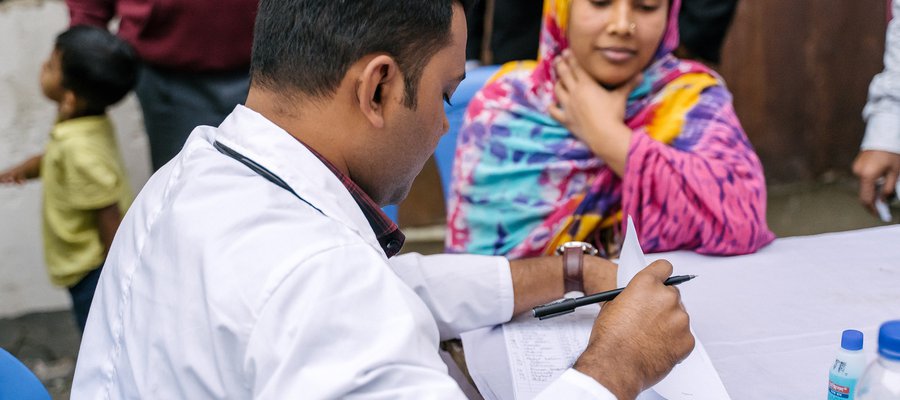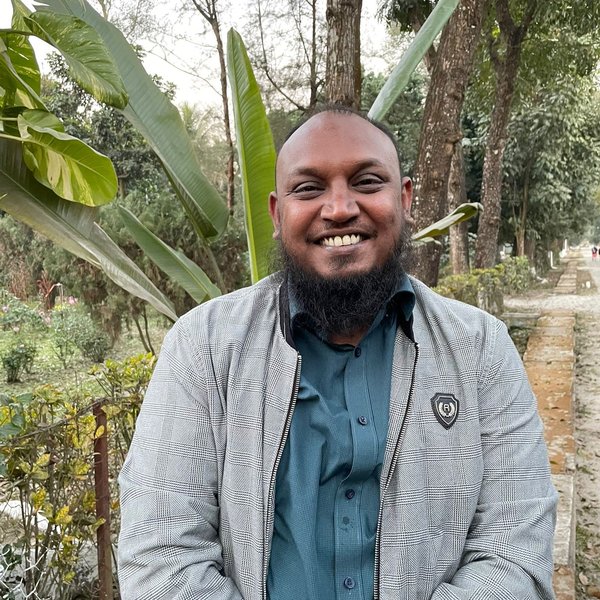Research in Bangladesh

Leading the way on transmission and reaction research
Our research activities in Bangladesh are coordinated by Dr Abu Sufian Chowdhury, Clinical Research Coordinator, under the guidance of Dr Rishad Choudhury Robin, our Research Advisor. Together with Dr Chowdhury, Dr Abhijit Saha, Research Manager, and Ms Tanjum Ara Haque, Laboratory Research Manager, play a vital role in ensuring the smooth implementation of ongoing research projects as well as in securing new research grants.
Since 2023, through the initiative titled "Leprosy Field Research in Bangladesh (LepFire)", our research operations have expanded across multiple regions of the country. This nationwide coverage allows us to conduct population-based studies, which are crucial for enhancing our understanding of leprosy.
Our research focuses on various dimensions of the disease—ranging from strategies to interrupt transmission to efforts aimed at reducing leprosy-related disabilities. The field research infrastructure in Bangladesh forms an integral part of several global research consortia, enabling meaningful contributions to international efforts in leprosy control and innovation.
Zero Transmission
There is an urgent need for field-applicable diagnostic tools that detect infection with Mycobacterium leprae. The Global Leprosy Strategy 2021-2030 has identified point-of-care diagnostic tests as a key research topic.
In partnership with Leiden University and Erasmus MC in the Netherlands, TLM Bangladesh are testing a field-friendly finger-prick test for leprosy. This test could diagnose individuals within five minutes, allowing us to treat them quickly, thereby increasing our chances of preventing both transmission and disability.
Anoukvan Hooij, Elisa M.Tjon Kon Fat, Danielle de Jong, Marufa Khatun, Santosh Soren, Abu Sufian Chowdhury, Johan Chandra Roy, Khorshed Alam, Jong-Pill Kim, Jan Hendrik Richardus Annemieke Geluk, Paul L.A.M.Corstjens. Prototype multi-biomarker test for point-of-care leprosy diagnostics. iScience: Volume 24, Issue 1, 22 January 2021, 102006 https://doi.org/10.1016/j.isci.2020.102006
van Hooij A, van den Eeden SJ, Richardus JH, Geluk A. Quantitative lateral flow strip assays as user-friendly tools to detect biomarker profiles for leprosy. Scientific Reports. 2016; https://pubmed.ncbi.nlm.nih.gov/34090257/
Tió-Coma M, van den Eeden SJ, Mei H, Roy JC, Richardus JH, Geluk A. Blood RNA signatures for early detection of leprosy among contacts in Bangladesh. EBioMedicine. 2019; https://pubmed.ncbi.nlm.nih.gov/31422044/
Tió-Coma M, Kiełbasa SM, van den Eeden SJ, Mei H, Roy JC, Wallinga J, et al. Blood RNA signature RISK4LEP predicts leprosy years before clinical onset. Frontiers in Microbiology. 2020; https://doi.org/10.3389/fmicb.2020.01220
Kiełbasa SM, Tió-Coma M, van den Eeden SJ, Mei H, Roy JC, Richardus JH, Geluk A. Longitudinal immune signatures in contacts of leprosy patients highlight early host response to Mycobacterium leprae infection. Frontiers in Immunology. 2020; https://doi.org/10.3389/fimmu.2020.01811
van Hooij A, Tjon Kon Fat EM, Richardus JH, Geluk A. Application of new host biomarker profiles in quantitative point-of-care tests facilitates leprosy diagnosis in the field. EBioMedicine. 2021; https://pubmed.ncbi.nlm.nih.gov/34688497/
Tió-Coma M, van Hooij A, Bobosha K, van den Eeden SJ, van der Ploeg-van Schip JJ, Banu S, et al. Development and validation of a multiplex real-time PCR assay for diagnosis of leprosy using skin biopsy specimens. PLoS Neglected Tropical Diseases. 2021; https://pubmed.ncbi.nlm.nih.gov/33490914/
van Hooij A, Tjon Kon Fat EM, Richardus JH, Geluk A. Prototype multi-biomarker test for point-of-care leprosy diagnostics. iScience. 2021; https://pubmed.ncbi.nlm.nih.gov/32849645/
van Hooij A, Geluk A, Tió-Coma M, Richardus JH. Advancements in biomarker research for leprosy diagnosis and treatment monitoring: a comprehensive review. Infectious Diseases of Poverty. 2024; https://doi.org/10.1186/s40249-024-01262-9
van den Eeden SJ, Kiełbasa SM, Tió-Coma M, Mei H, Roy JC, Richardus JH, Geluk A. Longitudinal blood transcriptional biomarkers predict leprosy years before clinical onset. Scientific Reports. 2025; https://doi.org/10.1038/s41598-025-91995-w
Post-exposure prophylaxis (PEP)
The World Health Organization started recommending single-dose rifampicin for post-exposure prophylaxis (PEP) in contacts of leprosy patients in 2018. It is one of the key components of the Global Leprosy Strategy 2021-2030.
This recommendation is a result of, in no small part, the research conducted in North-West Bangladesh by our research team as part of the COLEP study group. In summary, they demonstrated that a single dose of rifampicin given to contacts of new patients with leprosy is 57% effective in preventing the development of clinical leprosy after two years
Moet FJ, Pahan D, Oskam L, Richardus JH for the COLEP study group. Effectiveness of single dose rifampicin in preventing leprosy in close contacts of patients with newly diagnosed leprosy: cluster randomized controlled trial, BMJ 2008, 336, p761-4
Immunoprophylaxis
Based on the experiences with BCG vaccination and SDR chemoprophylaxis in preventing leprosy among contacts of leprosy patients, a trial was initiated in Bangladesh to assess the efficacy of a combined strategy (acronym: MALTALEP study, named after the main sponsor of the research project)
The MALTALEP study demonstrated that “Combined chemoprophylaxis and immunoprophylaxis is potentially a very powerful and innovative tool aimed at contacts of leprosy patients that could reduce the transmission of M. leprae markedly.”
Richardus et al. The combined effect of chemoprophylaxis with single dose rifampicin and immunoprophylaxis with BCG to prevent leprosy in contacts of newly diagnosed leprosy cases: a cluster randomized controlled trial (MALTALEP study). BMC Infectious Diseases 2013 13:456 doi:10.1186/1471-2334-13-456
We know that:
- The number of newly detected leprosy cases worldwide has remained stable over the last ten years.
- Household contacts of leprosy cases are at increased risk of leprosy development.
- Household contact examinations and case detection are critical aspects of leprosy control.
Since it is known that members of the household of a person newly diagnosed with leprosy have a higher risk (than the general population) of becoming leprosy cases, it is normal practice to offer them physical examination on at least one occasion to confirm or exclude leprosy. It is not clear from available published evidence whether re-examinations at annual intervals are useful or for how long they should continue. It is also not known whether amongst all household members, who are not are equally at risk, some could be identified who would benefit from a more intensive or longer period of surveillance.
TLM Bangladesh’s Contact Cohort Analysis (COCOA) Study is the largest, most comprehensive study of development of leprosy in household contacts conducted recently. We followed up some of the study participants for up to 21 years. A large quantity of good quality data has been collected, some of which we are still analysing. However as a result of the study covering households of 11,221 leprosy cases diagnosed within past 20 years, the staff have detected an extra 82 new cases amongst the 50,260 contacts enrolled as subjects.
The data suggest that contacts may be at higher risk, and that contacts of cases who are multibacillary type or have positive skin smears or have more advanced disability at diagnosis are also at higher risk.
Why is this important? Prioritising households known to be at highest risk of leprosy development (contacts of multi-bacillary cases) would allow efficient allocation of resources.
Quilter EEV, Butlin CR, Singh S, Alam K, Lockwood DNJ (2020) Patients with skin smear positive leprosy in Bangladesh are the main risk factor for leprosy development: 21-year follow-up in the household contact study (COCOA). PLoS Negl Trop Dis 14(10): e0008687. https://doi.org/10.1371/journal.pntd.0008687
Child Serosurvey Study
Study Overview
The multi-center Child Serosurvey study is designed to monitor Mycobacterium leprae transmission by measuring of anti-PGL-1 IgM antibodies in children aged 5 to 10 years. The study includes around 6000 children to be tested for the antibody in the northwest of Bangladesh. Since a preventive chemoprophylaxis PEP++ intervention is planned in Nilphamari and Rangpur Districts we propose to assess the baseline seroprevalence of children in these districts before the blanket approach and after 2 years. In addition, we will include Panchagarh District, where no PEP++ intervention will take place. The seroprevalence data will provide a baseline data of M. leprae infection among asymptomatic children, transmission hotspots, exposure trends, and relevant information on the effect of PEP++ on transmission of M. leprae in a population.
PEP++ Study
The PEP++ (Post-Exposure Prophylaxis Plus Plus) Study is a clinical research initiative designed to evaluate an enhanced strategy for the prevention of leprosy among contacts of newly diagnosed patients. Building upon the original WHO-recommended PEP approach—which involves administering a single dose of rifampicin (SDR) to eligible contacts—the PEP++ study investigates the effectiveness of a more intensive, multidose rifampicin & clarithromycin regimen to further reduce the risk of leprosy transmission.
The study is being conducted in high-endemic countries which includes Bangladesh India, Nepal, Indonesia, and Brazil. It uses a randomized controlled trial design to compare the outcomes of standard SDR-PEP with the PEP++ intervention, typically involving 03 (three) doses of rifampicin & clarithromycin in 04 (four) weeks apart. The primary objective is to determine whether the PEP++ regimen offers superior protection against the development of leprosy among contacts, thereby accelerating disease elimination efforts.
Preliminary findings from the PEP++ study are expected to contribute valuable evidence toward global leprosy control policies and may inform future WHO guidelines for leprosy post-exposure prophylaxis.
Hinders DC, Taal AT, Lisam S, Rocha AM da, Banstola NL, Bhandari P, Kishore J, Fernandes VO, Saha A, Chowdhury AS, Noordende AT van ’t, Mieras L, Richardus JH, Brakel WH van. The PEP++ study protocol: A cluster-randomised controlled trial on the effectiveness of an enhanced regimen of post-exposure prophylaxis for close contacts of persons affected by leprosy to prevent disease transmission. 2024; https://doi.org/10.21203/rs.3.rs-3850260/v1
Zero Disability
Reaction (an acute inflammatory response) is the main cause of disability in people affected by leprosy. The better we understand why it happens, what the risk factors are, how to assess it and how to treat it, the more we are able to prevent nerve damage and disability.
Erythema nodosum leprosum (ENL) is an unpleasant complication of leprosy which can lead to considerable suffering, impaired quality of life, and long term disability. It can occur before, during or after successful treatment of the infection.
ENL is characterised by severe pain and the development of new painful skin lesions, but other organ systems are often affected. It continues to affect people for many years leading to disability, significant loss of income and sometimes death. The standard treatment is prolonged courses of corticosteroids, thalidomide or other drugs that modulate the immune system. Thalidomide is the most effective treatment but is not widely available or affordable in many leprosy endemic settings. This results in many people taking high doses of corticosteroids for prolonged periods and being at risk of severe adverse effects.
TLM Bangladesh is involved in a number of ENL studies as part of the Erythema Nodosum Leprosum International STudy Group
ENLIST ENL Severity Scale
The ENLIST ENL Severity Scale is the first valid, reliable and responsive measure of ENL severity and improves our ability to assess and compare patients and their treatments in this severe and difficult to manage complication of leprosy. Clinically it assists the monitoring and treatment of patients with ENL. It is easy to apply and will be useful as an outcome measure in treatment studies and enable the standardisation of other clinical and laboratory ENL research.
Methotrexate Study (ENLIST MTX)
The most effective treatment for ENL is thalidomide but this is not available in many leprosy endemic countries or severely constrained by availability, cost, adverse effects and justified concerns about foetal damage. Therefore, Thalidomide, despite its effectiveness is rarely used as a first line agent.
Other effective and preferably cheaper drugs need to be identified to reduce the burden of this condition. There is some evidence that methotrexate may be useful in helping to control the debilitating symptoms of ENL and reduce the amount of corticosteroid treatment needed. Methotrexate has been available since the 1950s and is used throughout the world to treat common conditions such as psoriasis. It is also inexpensive. The ENLIST-MTX study tests whether methotrexate is effective in ENL by comparing it with prednisolone (the corticosteroid most commonly used to treat ENL).
Extra Clofazimine for MB cases at high risk of ENL
Clofazimine has long been used to reduce severity and recurrence of ENL, however, there is limited published evidence for its effectiveness. This Leprosy Research Initiative funded study is testing the effectiveness of additional clofazimine in reducing the incidence and severity of ENL.
Why is this important? If we can reduce the frequency and severity of reactions, we can protect against nerve damage and the associated disabilities. The results of the study will help doctors decide best treatments for ENL patients in future.
Extra-Clofazimine Study
This multi-centre clinical trial, funded by the Leprosy Research Initiative (LRI), aims to find out whether administration of extra doses of Clofazimine for duration of 6-12 months to one group of patients who are suffering from ENL reactions can reduce the frequency and severity of the ENL reaction and its consequences. The other group of patients suffering from ENL reaction will be given placebo vitamin tablets to compare the difference in well-being between the two groups. Both groups will also receive standard treatment with steroids. The study will assess the results in each group by using standard scales for ENL severity and for quality of life as well as nerve damage and amount of steroid medication needed. The results will help doctors decide the best treatments for ENL patients in future.


